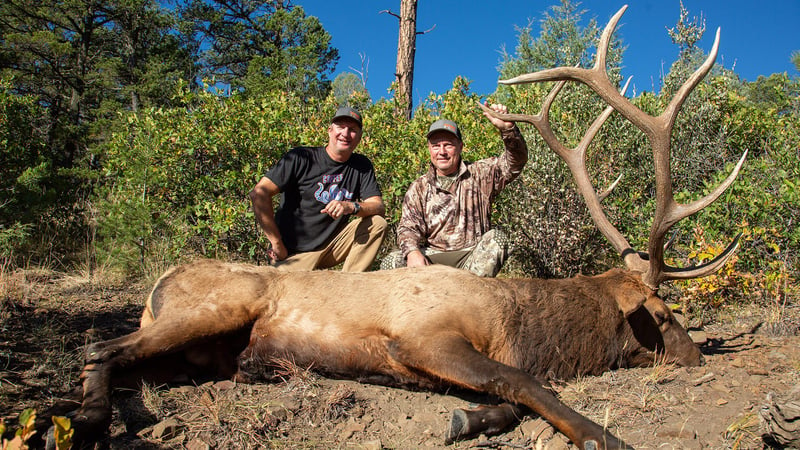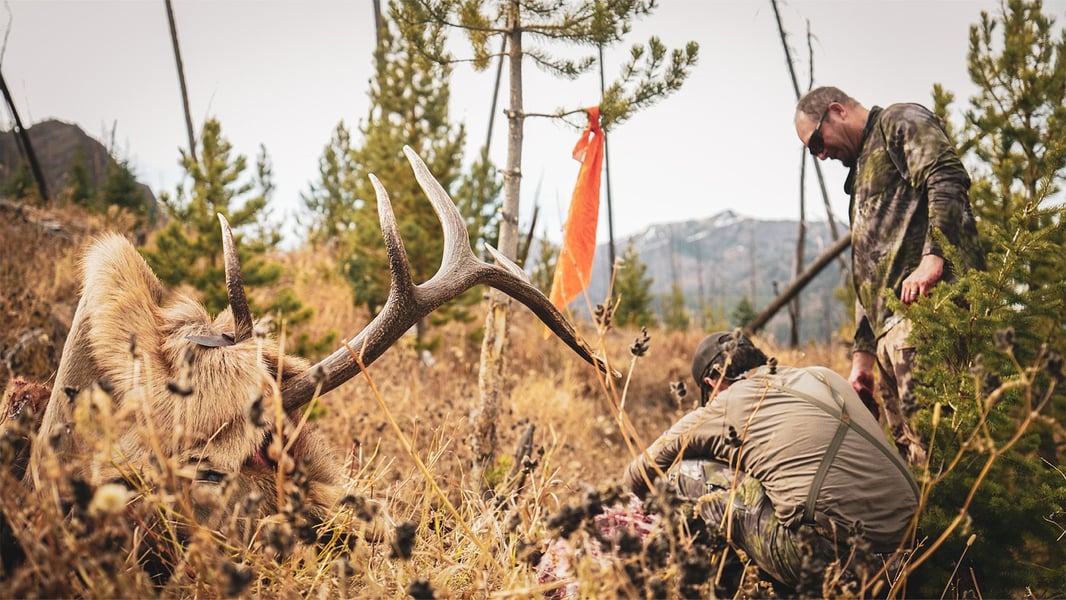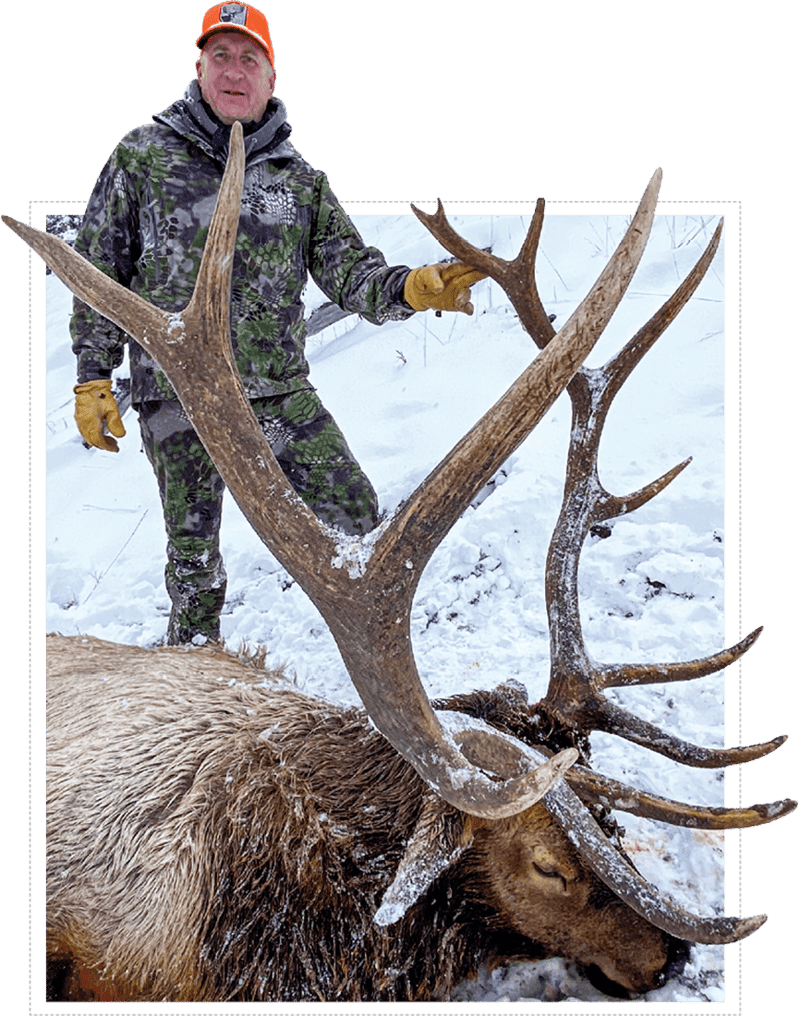Elk Strategies - Early to Late
By Todd Helms
On any elk hunt success begins with finding the elk. Sometimes it’s as easy as following your ears and nose, other times it can seem like they don’t exist, even when you know they are there. Once you’ve got them located it’s time to strategize to seal the deal and punch your tag. It’s the how-to that we’re going to break down in this article, from locating elk to hunting strategies through the stages of a bull elk’s behavior from the pre-rut, rut, post-rut and the late-season. All of this knowledge has been borrowed and put into practice from Mike Eastman’s book Elk Hunting the West: Revisited which is available both at eastmans.com and with a TagHub premium subscription. With that, let’s get to the nitty gritty of making this your best fall of elk hunting ever!
First things first, we need to understand that a trophy bull elk’s needs change from late August to November or December and his needs dictate both his location and his behavior. Let’s start with the early season bull. Also, bear in mind that these time windows are approximate and vary slightly given the region you’re in.

Early Season (Late August – Labor Day)
When I say early season I’m talking about late August and the first couple weeks of September in most of the American elk’s range. I’m also of the opinion that this is the one of the best times of year to take a true trophy bull. Obviously, there are exceptions, but bulls this time of year are lazy. They’re fat and happy from a summer of eating prime groceries and growing antlers. It’s normally hot across the Rocky Mountain West this time of year and bulls won’t be on their feet much during daylight hours. In elk country with mountains trophy bulls will summer up high in the alpine or on high, timbered ridges with open basins and parks. Mountain bulls will have water at their disposal so that’s not as big of a concern but open, arid country bulls won’t be far from a water source as they need to water at least twice per day. Keep this in mind when hunting low, sage country or desert elk and begin your search around water.
Your best bet for locating early-season bulls is to scour vast swathes of country from a master vantage point with good optics. Elk are easy to glass up as they can be seen from a long way away. Chances are if you’re spotting lots of cows and calves you’re not looking in rugged enough or high enough terrain to find the big bulls; they will not be around the cows in early autumn. Expand your search to higher and more rugged country.
Once you’ve located the bull or bulls you’re after it’s time to get sneaky. This is NOT the time for calling, not yet. There are two times of year when a bull elk is semi-patternable; early autumn and late autumn, think pre-rut and late-season. This is when his life is all about security, food and water. In late August or early September a bull’s mind is not on cows. Sure, he may be shredding some trees, cleaning up the remainder of his summer velvet, he may even wallow a bit but it’ll be a couple weeks before he gets serious about rutting.
Your strategy here is to spend some time watching where he likes to feed in the mornings and evenings, with his evening feed being your best opportunity to slip in and harvest him. He will be relaxed but not stupid and you’ll need to be stealthy as he’s only going to give you one chance. That said, even a big bull can be curious in early September and come to investigate realistic bugling. Don’t get aggressive with it unless he does and be ready for a silent approach as he’ll most likely slip in downwind to check out what he thinks is a strange bull in his territory. Calling this time of year can be high reward but it’s risky, if you blow him out he’ll be gone for days if not the entire season. Your best bet is to play your cards close to the chest and use a perfectly timed stalk or ambush to punch your tag on a big early season bull. This is a great time of year to sit a wallow or on water.

The Pre-Rut (First Weeks of September)
The biggest, baddest bulls are beginning to feel their oats about this time of the fall. Obviously, timing of the pre-rut and rut varies from location to location and year to year. Overall though, the first two weeks of September find big, mature bulls in limbo; they’re getting fired up and will be bugling, wallowing and rubbing actively but will most likely not be with the cows just yet. He’s still going to be focused on feed and water in the mornings and evenings and will most likely still be in his summer home but he can disappear overnight, moving miles down into his rutting area. Keep in mind that a bull will rut in the same general area from year to year so prior experience and knowledge narrow the field of play dramatically.
Quite often the truly big guys will let the younger bulls do the hard work of breaking up the large summer cow and calf groups before they horn in and take whatever they want. When you find a bull you want this time of year, be aggressive and make your move, he likely won’t stick around very long.
Again, wise and realistic bugling can get a big bull excited this time of year and he just might slip up and come roaring in if you challenge him. He also will be interested in cow calling but not as much as he will in a week or two. Play it cool, stalk him if you can and if you can’t, go for broke and call to him. Unless you know his routine and that he’s not going to leave then bide your time and only make your move when everything is perfect. These pre-rut days can be dynamite sitting and watching a wallow when all else fails.

The Rut (Last Weeks of September-First Days of October)
This is a magical time of year for an elk hunter, screaming bulls, frenzied elk behavior and tensions through the roof. It’s also one of the most difficult times to harvest a trophy bull. Sure, you can find them easily enough but 9 times out of 10 they’re locked down with a herd of cows. Not to mention that true rifle rut hunts are as rare as hen’s teeth and getting close enough to kill a big, mature bull with archery or even most muzzleloaders can be tricky with all those eyes, ears, and most importantly, noses to fool.
IF you find yourself with a rifle tag during this time period count your blessings and look over as many bulls as possible to find that truly next level monarch. You’ll never have a better chance than this when he’s very vulnerable. Glassing, listening and being aggressive with your approaches are the go to tactics. An Eastmans’ favorite is to ghost a moving herd, playing the wind and slicing in to intercept a bugling bull as he’s traveling to bed or feed.
Too many hunters make the mistake of relying on calling this time of year. The really big bulls will most likely bugle at you but not leave their harems. There are instances when a mature bull has been separated from his cows and is susceptible to calling but the window for this is small and extremely hard to pin down. If it happens at all it will be during midday when he gets up to make the rounds, often leaving his cows to wallow and drink. At this time he will gladly attempt to pick you up if you’re in the right spot and sound like an innocent cow needing his attention. Another instance when this occurs is if a bull has his cows taken from him by a more aggressive bull and finds himself alone and lovesick, he will come tromping in to well-timed cow calls.
Just keep in mind that the further you get into October the more likely the biggest bulls will disappear and it will happen in a matter of hours. A couple years back a friend of mine killed a monster of a bull on the opening day of his Wyoming season. He killed the bull in the same alpine timber patch the bull had summered in. I called the bull in two days prior and over 10 miles away as the rut was winding down for him. The point? Truly big bulls don’t spend any more time with cows than they have to, then it’s the bachelor life for the most part for the rest of fall. The rut is fun but can be a very difficult time to harvest a true monster.

Post Rut (First Half of October)
There is an extremely short window of opportunity in the first few days of the post rut when a big bull has left his cows but is still very susceptible to cow calling. Don’t expect him to move far to come find you but he won’t miss out on one last chance to breed. Quite often a big bull will “troll” for unbred cows as he works his way back to where he summered to recoup from the rigors of the rut.
Your best bet here is to troll as well; cover ground and cow call. Calling into the heads of thick drainages or from open ridges down into thick or rugged bottoms will do the trick. If he’s there and hears you he won’t dawdle in his response. You need to make the most of this situation as big bulls during this time period don’t hang around long, they are anxious to get some rest.
If you cannot locate a big bull via calling then you’ll need to let your glass do the work for you. Chances are the biggest bulls are looking for nasty, steep, remote or thick country to go hide away in for a couple of weeks. They can be terribly difficult to find as the days run deeper into October. They’ve been going nonstop for weeks and all they want to do is lay low and recover. It’s like having a hangover; sleep and a little food are all you really want, same for big rut-weary bulls and it’s the exact reason why this is the most difficult time to take a big mature bull. They simply do not spend much time on their feet or in the open. You must be willing to be on your glassing points early and late, if this means long hikes or horse rides in the dark through grizzly infested timber, well, saddle up partner; what doesn’t kill you makes you stronger! A big, trophy bull during this time of year will only be visible during the first or last few minutes of legal shooting light. He’s a tough customer to tag but his schedule will loosen up as the days get short, the mercury plummets and the snow piles up; the late-season!

The Late-Season (Late October – December)
Like each of these time frames the timing for the late-season varies depending on where you’re hunting but as a general rule of thumb it runs from the last week of October through the end of hunting seasons in November or December. It is also quickly becoming my favorite time to hunt big bulls. They have recovered from the rut and are 100% focused on packing away some calories for winter, that means they spend more time in the open feeding and are easier to spot and stalk. They will be concentrating on south-facing or open slopes where the best feed is and will be out and visible for longer in the mornings and earlier in the evenings. That said, they still aren’t pushovers and the biggest, oldest bulls will never be far from security cover.
Once again, big sweeping vistas with master vantage points are what you need to find to locate these late season bulls. Glass early and late and go take a nap during the middle of the day. My personal favorite way to hunt these bulls is to spend a couple evenings and mornings glassing and narrowing my search. I take notes on where I’m spotting bulls and at what time. If I’m seeing bulls on their feet late into the morning then I’ll plan a morning hunt. Most of the time however late season hunts are evening affairs as the elk don’t normally give you much time in the mornings before they’ve put away for the day in the timber. Yes, you can hunt the timber but your odds of taking a true trophy bull this way are extremely low. That’s why I like to play my hand in the evenings.
Bulls are fairly patternable during the late season and will generally feed and bed in the same places if undisturbed. This gives us an enormous advantage if we take the time to watch them. I like to slip into a bull’s evening feed and set up during the late afternoon to wait for him to work his way into a shootable or stalkable spot. Bear in mind that the wind has to be perfect and I never set up too close just in case it swirls. Late-season hunts are most often rifle hunts so getting closer than a couple of hundred yards isn’t necessary, in fact giving bulls some cushion is better than being up close and personal, it gives you more margin for error.
Even though I prefer evening hunts in the late-season there are times when you can get on bulls in the morning as well. Normally this occurs when the temperature is well below zero and bulls are loath to leave good feed. When you find yourself in this position be sure you’re up early and ready to move quickly. I had this exact scenario with my father’s bull last December. It was very cold, well below zero, and the elk were staying on feed later than they normally would. This gave us the opportunity to slip in quickly at first light and seal the deal on a big old broken beamed bull.
If I had to pick a “best” time to kill a mature, trophy bull it would be during the late season. These tags are normally very limited and come dear in the draws for good reason. There are, however, some of these hunts available as general tags across the West and Eastmans’ TagHub can help you find them. Arizona, Idaho, Montana and Wyoming come to mind but for the best of the best you’ll want to have your name in the ring of limited quota or draw tags.
Well, that’s it… my breakdown of how to locate and hunt elk through the different life cycles of a trophy bull in the autumn months. Now it’s up to you to get out there and get after ‘em. Remember, when you take that monster bull, be sure to submit your story and images to [email protected] and you just might see yourself in the pages of EBJ or EHJ… Is it September yet?





